Imjin War. Battle for the sea
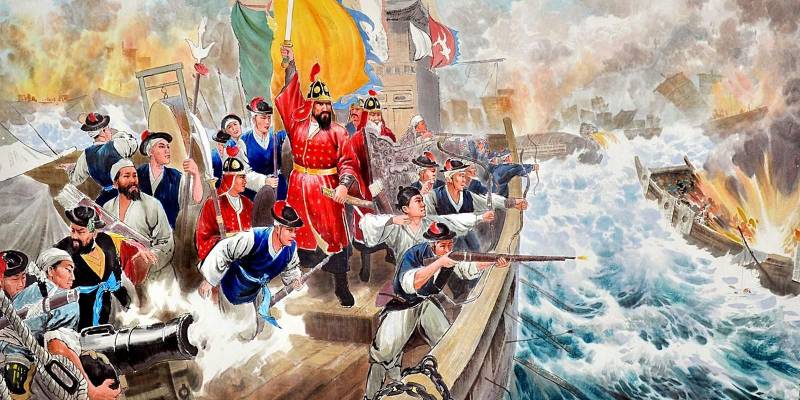
When planning the Korean campaign, Toyotomi Hideyoshi did not take into account one important circumstance - the Koreans had a strong naval fleet. Unlike the land army, he had extensive experience in dealing with Japanese pirates, so the Korean sailors had an idea about the tactics of a potential enemy. In a situation where most of Korea was occupied by a strong and cruel enemy, it was the Korean fleet that managed to turn the tide of hostilities. The man who put an end to Hideyoshi's ambitious plans was Admiral Li Sunshin (1545–1598).
The biography of the future national hero of Korea was dramatic, replete with ups and downs. Li Sunxing could not boast of favorable starting conditions for a career - his grandfather, who belonged to the court group of Confucian reformers, was convicted on false charges of treason and expelled from the palace in disgrace. The family was considered politically unreliable and lived in poverty. Nevertheless, thanks to the efforts of his father, Lee Sun-sin was able to receive a decent education.
His childhood friend was Yu Sungnyeon, who later became a high-ranking official in the kingdom. In the future, Yu Songnyeon will promote the appointment of Lee Sunsin to the post of admiral, and his intercession will save the illustrious military leader from death.
Coming from an unreliable family, Yi Sun-sin could not qualify for the role of a civil official, but could choose military service, which was considered less prestigious in Confucian Korea. He learned the basics of military affairs at the Royal Military Academy in Seoul, after which he tried to pass the state exam for an officer's rank. The first attempt was unsuccessful - during the surrender of horse archery, Lee fell off his horse and broke his leg.
Despite the pain, he bandaged his leg with willow bark on his own, mounted his horse, and completed the exercise. The exam was not counted, but the stamina and perseverance of the young cadet amazed the examiners. At the age of 32, during a second attempt, he successfully passed the exam and was able to start a military career. The young officer was sent to serve on the border with Manchuria, where nomadic Jurchen tribes raided the border regions of Korea. Later, Li served in the south of the country, where he led the naval base.
Having deeply learned the principles of Confucianism, Li Sunxing did not tolerate bribery and nepotism and made many enemies for himself. Lee's detractors among colleagues and senior officials were able to get him fired by accusing him of negligence in the line of duty. But it soon became clear that the charges were falsified, and Li Sunsin was able to continue his military career. Soon he was transferred to the northeastern province of Hamgyongdo, where he began his military service.
Repelling the raids of the militant Jurchens, Li Songxing showed military abilities and personal courage. However, a new test soon awaited him. After an unexpected attack by the Jurchens on one of the border forts and the death of its garrison, the commander Li Il, who feared punishment for his miscalculations that led to the tragedy, laid the blame for what had happened on Li Songsin. He was threatened with the death penalty, but by virtue of his merits they saved his life and demoted him to the rank and file.
A few months later, Li Sunxing was able to distinguish himself again on the battlefield, and Li Il's abuses became known at court, as a result of which all military ranks were returned to our hero, and his good name was restored.
In 1591, Yi Songsin was appointed commander of a part of the fleet that defended Jeolla Province. Assuming a new position, he showed himself to be an energetic organizer and almost immediately began to restore the forts and strengthen the bays. But the admiral paid the greatest attention to strengthening the battle fleet and training sailors and officers.
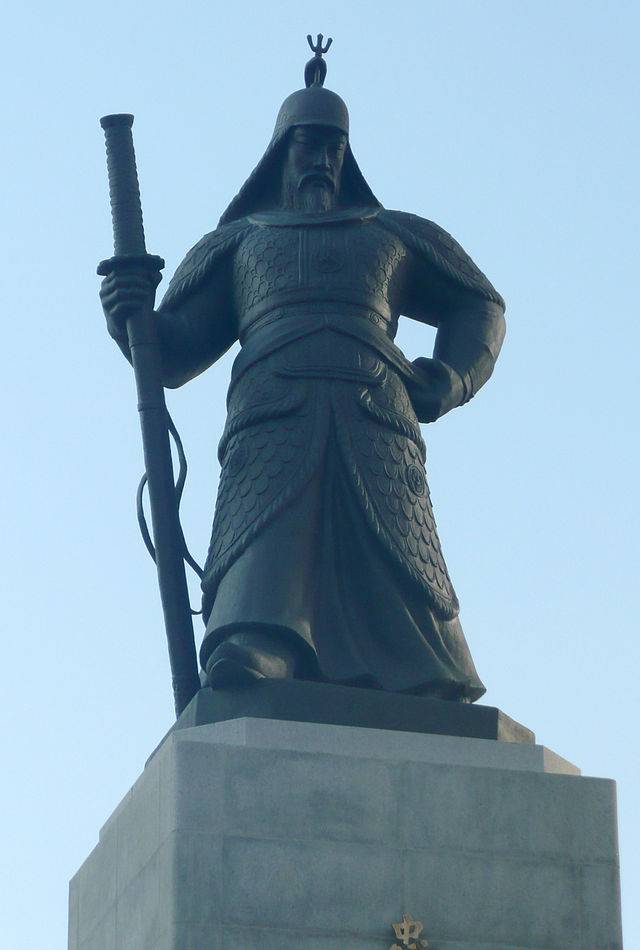
Monument to Admiral Lee Sunsin in Seoul
On the eve of the war, the naval forces covering the two southern provinces of Korea - Jeollado and Gyeongsangdo, consisted of four parts, led by their own commanders. The shores of the southeastern province of Gyeongsangdo were defended by the flotilla of the left semiprovince of Gyeongsangdo, led by Pak Khon (eastern) and the flotilla of the right semiprovince of Gyeongsangdo (western) under the command of Won Gyun. The defense of the southwestern province of Jeollado from the sea was built on the same principle. The flotilla of the right semi-province was led by Li Okki, and the flotilla of the left was led by Li Sunsin.
With a strong navy, the Koreans could prevent the Japanese from landing and destroy them at sea, but events went according to a different scenario.
The appearance of the Japanese armada near Busan took the commanders of the Gyeongsang Province fleet by surprise. Pak Hong and Won Gyun, with a total of more than 250 warships, silently watched what was happening, in no way preventing the Japanese from landing on Korean soil. Finally, Pak's nerves could not stand it, he ordered to flood his ships, and he disappeared. Won Gyun also acted cowardly. Only four ships survived from the numerous fleet of Gyeongsang Province, and such catastrophic losses were caused not by the skillful actions of the enemy, but solely by the cowardice and incompetence of their own commanders.
With the pitiful remnants of his flotilla, Won Gyun hid in one of the bays that abound on the southern coast of Korea, and sent a letter to his colleague Lee Sung-sin, pleading for help. Despite Vaughn's desperate pleas, Li was in no hurry to engage in battle with the Japanese fleet. In an effort to better prepare for a meeting with the enemy, Lee Sunsin considered it necessary to collect intelligence information about the intentions and movements of the Japanese. In addition, he wanted to form a combined fleet with Lee Okka's flotilla, which would allow him to have 90 warships on hand. Finally, before going into battle with the enemy, Li Sunxin had to be sure of the morale of his subordinates. The admiral stopped the defeatist mood with an iron fist: several people who tried to desert were executed, and their heads were put on public display.
However, on June 12, the day the Japanese troops entered Seoul, Lee Sunsin suddenly received an order from King Seongjo to join forces with Won Gyun. The next day, Lee Sun-sin left the harbor of the port of Yeosu and moved with his flotilla to the east.
Korean Navy
Before talking about the fighting at sea, we should briefly mention what the opposing fleets were like.
For the invasion of Korea, Hideyoshi assembled an impressive fleet of about 1 ships and 000 crew members. However, most of it was made up of transport ships designed to transport warriors, and not for naval combat. Even warships were armed with very few guns and could not compete with Korean ships. The commanders in charge of the Japanese fleet had little or no naval experience. The only exceptions were people from among the Japanese pirates (wako), but there were few of them, since shortly before the war, the Japanese ruler launched an active struggle to eradicate piracy. In an effort to strengthen his fleet, back in 1586, Hideyoshi, through the mediation of Catholic missionaries operating in Japan, tried to get two ships from Portugal along with teams to go to China and Korea, but was refused. As a result, the fleet remained the weak link in Hideyoshi's armed forces.
The Korean navy proved to be much better prepared for war than the land army. The constant attacks of Japanese pirates on the coastal regions of Korea led to the fact that a significant part of the sailors and commanders had either combat experience or a general idea of the enemy with whom they were to fight. The need to have a combat-ready fleet also stimulated the development of shipbuilding in Korea.
At the start of the war, the main type of warship in the Korean Navy was phanokson. It was a flat-bottomed galley-type vessel with a length of 15 to 35 meters. The total crew size was 125 people. On the lower deck of the ship were rowers and drummers, while on the upper deck there were armed fighters - archers, gunners and officers. The upper deck served as a roof for the rowers, protecting them from the arrows and spears of the enemy. The flat bottom of the ship allowed him to quickly maneuver, and the high sides made it difficult to board the ship.
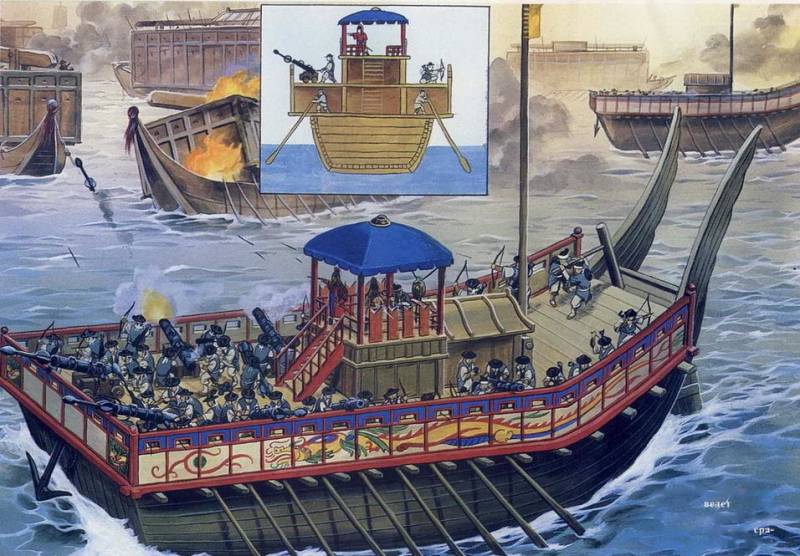
Phanokseong is the most common warship in the Korean Navy.
An important role in the naval battles that took place in the coastal waters of the Korean Peninsula was played by cobuxons ("turtle ships"). They were first mentioned in the Annals of the Joseon Dynasty in 1413, but on the eve of the war, Yi Sunsin, with the help of a skilled designer Na Daeyong, was able to improve this type of ship.
We don't know exactly what it looked like. kobukson, however, two descriptions of this ship are most credible. The first of them belongs to the pen of Lee Sunsin himself. In one of his reports to the king, he described him as follows:
Another description was left by Li Pun, Admiral Li's nephew:
A passage in the form of a cross was left on the upper deck. The rest of the deck is strewn with iron spikes that will prevent the enemy from landing for boarding ...
The nose is made in the form of a dragon's head, and the steering wheel is made in the form of a turtle's tail. On both sides of the dragon's head there is a gun port, 6 more are located on each side. It is called Kobukson for its shape ...
Thus, according to the descriptions made by Lee and his nephew, the prow of the ship was shaped like a dragon's head, and at least one medium-sized cannon was installed inside it. The deck of the kobukson was covered with a canopy shaped like a turtle shell, equipped with sharp iron spikes, which made it much more difficult to board the ship. On the sides there were 12 holes in which it was possible to install guns. In total, the "turtle ship" was supposedly armed with 30-40 guns.
Many authors claim that the deck roof that protected the ship from boarding was covered with iron sheets, and on this basis they conclude that the Koreans were the first in the world stories armadillos were used. The metal covering of the deck can also be seen on the models of kobukson made by modern Korean reenactors. However, firstly, cases of building ships sheathed with metal plates have happened before.
In particular, in 1578, the famous Japanese commander Oda Nobunaga ordered the construction of six ships with iron-plated sides and equipped with artillery and used them in the battle against the Mori clan that opposed him then. Secondly, there is no indication in the above evidence that cobuxons had metal armor. Many modern researchers believe that their armor was thick wooden boards that reliably protected the ship from bullets and arrows and even cannonballs, and not iron plates.
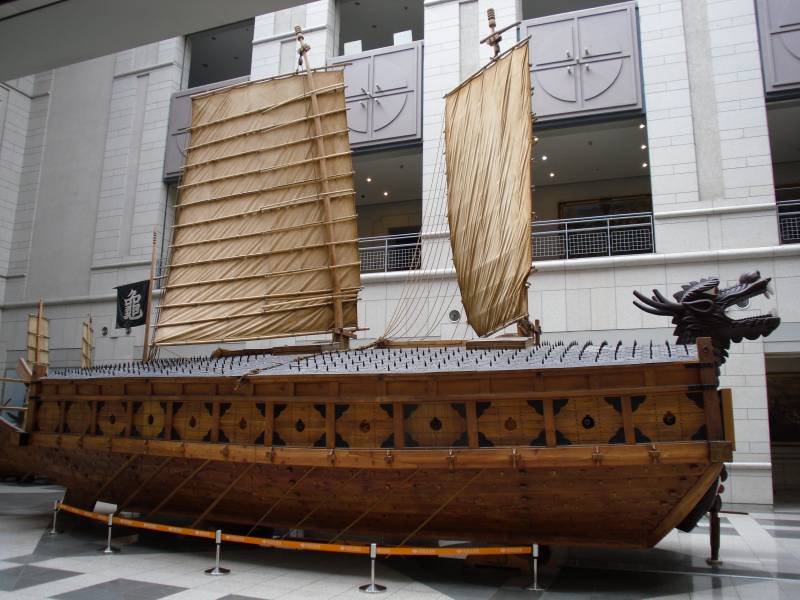
Modern reconstruction of the kobukson. Republic of Korea War Memorial in Seoul. Author's photo
Like the Chinese, the Koreans paid great attention to naval artillery. In total, there were five types of guns on Korean ships. In battle, cannons fired iron cannonballs, stones and grapeshot at the enemy. "Sky Guns"cheongja) could shoot giant wooden arrows with iron tips. Sometimes these were fiery arrows fired to set fire to enemy ships.
Thus, unlike the land army, the Korean fleet was a fairly serious force.
Leaving Yeosu, Li Sunxin led 39 warships under his command (24 panoksona and 15 narrow-deck ships hopson), as well as 46 small boats that performed reconnaissance functions. Linking up with the remnants of Won Gyun's fleet, Lee moved east along Geojedo Island. Suddenly, scouts reported that a Japanese fleet had been seen in the Okpo harbor in the east of the island. It was here that the first naval battle of this war took place.
Approaching Okpo, the Koreans found over 50 enemy transport ships in the bay. As he lined up his fleet for battle, Yi Sunxin placed the large ships in the center and the smaller ships on the flanks, and gave the order to attack. Most of the Japanese at that moment were on the shore, where they were plundering a nearby village. The invaders burned the village houses, and because of the smoke rising over the village, they did not notice the Korean ships until they were visible from the shore. Taken by surprise, the Japanese rushed to their ships, trying to escape on them. The Koreans took the enemy in pincers and brought down a hail of cannonballs and fiery arrows on enemy ships.
The Japanese responded with volleys from muskets, but this weapon, so effective on land, turned out to be powerless against well-defended phanoxons. The Japanese could not take the Korean ships for boarding, since the heavy fire of the Korean artillery in the bud stopped any attempts by the Japanese ships to approach. The fire of the Korean guns disabled one enemy ship after another. Many Japanese were killed, the survivors got ashore and hid in the surrounding forest.
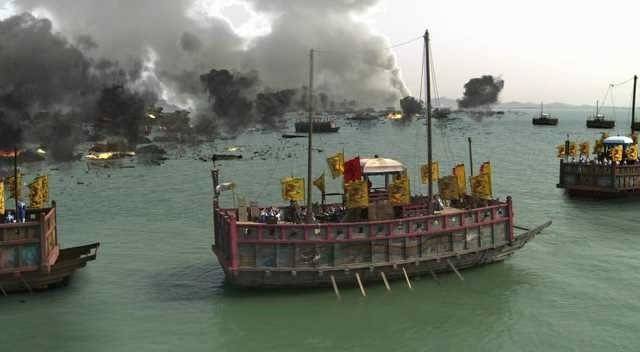
Battle of Okpo. Images from the TV series "Chinbirok: Imjin War" (Episode 19, 2015)
In the evening of the same day, five more Japanese ships were discovered in the Hapho area. Four of them were burned by Korean cannonballs and fire arrows. By the end of the day, 26 Japanese ships were destroyed, while the Koreans had no losses.
The next morning, Yi Sun-sin ran into a small Japanese squadron of 13 ships and destroyed 11 of them. This victory, like the previous one, also went to the Koreans easily and without any losses. The victors captured rich booty, including armor and ornate samurai helmets. Part of the trophies was sent to the royal court along with a message of victory.
After the victory, Yi Sun-sin returned with his fleet to his naval base in Yeosu in order to rest the Korean sailors and reorganize their forces.
The defeats of the Japanese at sea showed the Japanese that the Korean fleet was by no means out of the game and posed a serious threat. In early July, the command of the Japanese fleet decided to destroy the forces of Li Songsin. Having learned about the intentions of the enemy, the admiral did not wait until the Japanese gathered strength, and opposed them with only 23 ships. This time he brought with him one kobukson. Soon the turtle ship was to have a baptism of fire. On the way, Lee was joined by three ships under the command of Won Gyun.
On July 8, 1592, Yi Sun-sin and Won Gyun discovered the Japanese fleet near the port of Sacheon. It consisted of 50 ships, including 12 combat ships. The Japanese soldiers set up fortified positions on the rocks overlooking the bay. The command post of the commander of the Japanese fleet was also located there.
Thus, the Japanese fleet, stationed in the bay, could count on active fire support from land. Under these conditions, an attack on the Japanese positions could lead to heavy losses of the Korean fleet. Then the admiral decided to lure the enemy into the open sea, playing on his self-confidence.
A small part of Lee's fleet rushed towards the bay and then turned back. The Japanese regarded this maneuver as a flight. The Japanese soldiers left their fortified positions and boarded the ships to pursue the fleeing, as it seemed to them, enemy. Seeing that his trick worked, and the Japanese were in the kill zone, the Korean admiral ordered to attack the enemy. First to fight kobukson. The turtle ship broke through the center of the enemy fleet and unleashed a flurry of cannonballs and arrows on the Japanese ships, sowing panic and death. The attempts of the Japanese to board him were unsuccessful, since the fire of the Korean artillery did not allow them to get closer. The fierceness of the battle is evidenced by a report sent by Li Sunsin to the royal court:
During the battle, Admiral Lee was wounded in the left shoulder by a bullet from an enemy musket. Despite being wounded, Li Sunxin continued to lead the battle. Only when the battle ended with the complete victory of the Korean fleet, the admiral, according to one version, personally removed the bullet from the wound with a dagger. However, according to Li Sunsin himself, "the bullet entered the left shoulder and exited through the back." One way or another, the wound was not fatal and did not affect the outcome of the battle. All Japanese ships that left the bay were destroyed in the battle.
The Battle of Sacheon was followed by a series of victories by Yi Sun-sin. In the battle of Tanpo, the admiral defeated a Japanese squadron of 21 ships. In this battle kobukson again broke the enemy formation, shooting from cannons and ramming Japanese ships. During the battle, the captain of one of the Korean ships, Kwon Chun, shot the commander of the Japanese squadron, Kurushima Michiyuki, with a bow. The death of the commander caused panic among the Japanese soldiers and put them to flight.
Soon, the fleet of Lee Sunsin and Won Gyun joined forces with Lee Okki's squadron and launched a new attack on the Japanese. In Tanhanpo Bay, the Koreans discovered a squadron of 26 Japanese ships. Using the same feigned retreat tactics as in the Battle of Sacheon, Yi Sun-sin was able to lure the enemy ships out of the bay into the open sea and destroy them all.
Despite the continued failure of the Koreans on land, in the third month of the war, their fleet, after a series of victories, was able to achieve dominance at sea. And although the Japanese troops fought successfully in the north of Korea and had already captured Pyongyang, they could not continue the campaign without the supply of rice and gunpowder. Since the beginning of the war, thousands of Japanese soldiers have died and been wounded in action, either out of action due to illness or left behind as garrisons in strategically important fortresses. Accordingly, the corps of Konishi and Kuroda, operating in the north, needed to be replenished in order to be able to withstand the numerous Chinese troops.
The 700-kilometer route from Pusan to Pyongyang, running mainly through mountainous terrain, was extremely inconvenient for a huge army with large supplies of provisions. The only effective supply route for Japanese troops in northwest Korea was through the Yellow Sea, which washed the Korean Peninsula from the west. However, the southwestern province of Jeollado was still not conquered by the Japanese. The victories of Li Sunsin at sea did not allow the Japanese fleet to break through during the Yellow Time and thereby jeopardized the supply of Japanese troops in the north, which created serious problems for the further plans of Hideyoshi and his generals.
In less than two months of fighting at sea, the Korean Navy destroyed or captured more than 100 Japanese ships. Thousands of Japanese found their deaths or were injured. During the same time, the Koreans lost only 11 killed and 26 wounded and not a single ship. Such successful actions at sea contrast sharply with a series of defeats in a land war.
How can one explain the Korean victories at sea? It would be a mistake to reduce them solely to the Korean "wonder weapon" - kobuksonsespecially since there were only a few of them. The main reason for the victories of the Korean fleet was the fact that Lee Sunsin managed to tactically outplay the enemy.
During the period of the Japanese Unification Wars, naval battles were rare, so Japanese ships served primarily as a vehicle for transporting fighters. In a naval battle, the Japanese tried to get as close as possible to enemy ships in order to board them. In boarding combat, the Japanese samurai would most likely have prevailed due to their high individual military skill, so the tactics of the Korean naval commander was to shoot enemy ships with cannons from a safe distance. As mentioned above, the artillery armament of the Japanese ships was extremely weak, as a result of which the Koreans shot the Japanese as if in a shooting range, incurring minimal losses themselves.
Another advantage of the Koreans was the greater centralization of command. Being the commander of the flotilla of the left semi-province of Jeollado in the first days of the war, during the fighting, Lee Sunsin became the de facto leader of the entire Korean fleet, which was also recognized by the royal court. At the same time, the Japanese fleet was divided into a number of squadrons, each of which operated independently. Among their commanders, there was no figure that could even closely compete with Yi Sunxing, both in authority and in naval talents.
The bloody waters of Hansando Island
Hideyoshi, having learned about the failures of the Japanese fleet, was furious. Admirals of the Japanese fleet - Kuki Yoshitaka, Kato Yoshiaki and Wakizaka Yasuharu received an order from an angry ruler to unite their squadrons and defeat Li Sunsin. But Wakizaka decided to act on his own, without looking back at his colleagues, and without waiting for them, he moved from Pusan to the west. Probably, the impatient admiral did not want to share the laurels of the winner with anyone. Under the command of Wakizaki there were 73 ships - 36 large multi-deck ships atakebune, 24 medium warships sekebune, 13 reconnaissance vessels kobaya.
Atakebune were large ships and were armed with many guns. The hull of the ship was sheathed with thick boards, in which loopholes were made for cannons, arquebusiers and archers. Medium warship sekebune was a smaller version atakebune, but, unlike the latter, was sharp-nosed. Crew sekebune consisted of 40 rowers, 30 soldiers, one cannon crew and 20 arquebusiers.
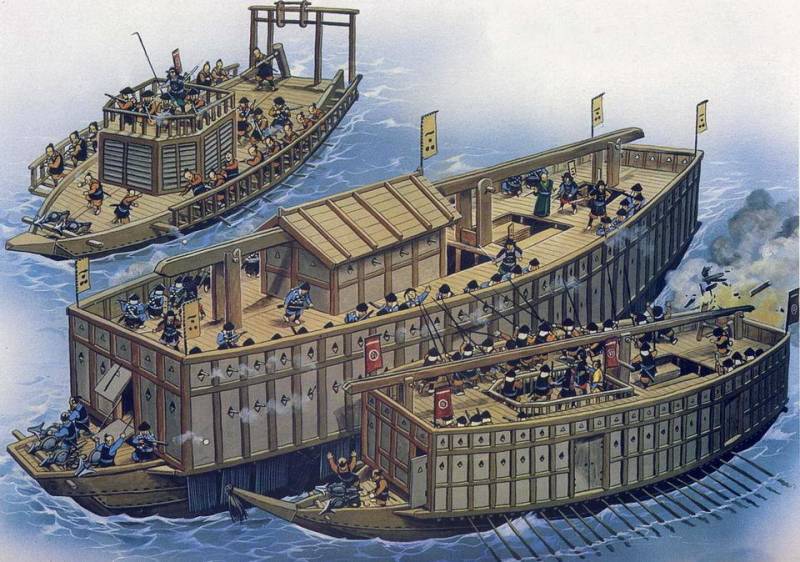
Japanese warships atakebune and sekebune
At that time, Korean ships were stationed in the bay of Hansando Island. The combined fleet of Lee Sunsin, Won Gyun and Lee Okki was 56 ships, including 3 kobukson. Upon learning that the enemy fleet was in the Gyeongneryang Strait between the Korean Peninsula and the island of Geojedo, Admiral Won Gyun, inspired by previous victories, offered to immediately attack the enemy. However, Li Sunsin, not without reason, feared that in the narrow strait, Korean ships might collide with each other or run into numerous rocks or reefs. Instead, Lee decided to lure the Japanese out to sea and give them a fight near Hansando Island, where the Korean ships could maneuver freely.
On the morning of August 14, Lee sent 6 phanoxons forward to lure the Japanese into a trap. When the ships were within sight of the Japanese fleet, they turned back and began to retreat rapidly. The bait worked - the glory-hungry Wakizaka Yasuharu ordered the pursuit to begin. When the Japanese ships appeared on the high seas, Li Sunsin ordered the fleet to line up in the "crane wing" battle formation. Heavy ships were placed in the center, while light ships were on the flanks. When everything was ready for the meeting, Admiral Lee gave the order to attack. More maneuverable Korean ships began to flank the Japanese, pouring arrows and cannonballs on them.
Meanwhile three kobukson, which constituted the center, dealt a crushing blow. They smashed Japanese ships to pieces, shooting them with cannons. Phanoksons from the flanks, enemy ships were also fired from cannons, preventing them from approaching for a boarding battle. The weak naval guns of the Japanese could not withstand the Korean naval artillery. Japanese ships burned with bright flames. Only with the onset of darkness, Li Sunsin ordered to stop the battle, which by that time had turned into a beating of a demoralized enemy.
Realizing that the battle was lost, Wakizaka Yasuharu fled the battlefield in a small, fast boat. Two relatives of the Japanese admiral fell in battle, several arrows hit Wakizaku himself, and only the shell saved him from death. The arrogance of the naval commander cost the Japanese dearly: of the 73 ships they had at the beginning of the battle, only 14 managed to escape. 59 ships were destroyed or captured by the Koreans.

Site of the Battle of Hansando. Modern look
Literally a few hours after the battle, Wakizaki's colleagues, Kuki Yoshitaka and Kato Yoshiaki, received news of the defeat near Hansando. They immediately sailed from Busan and anchored off Angolpo. Here they were joined by the remnants of Wakizaki Yasuharu's fleet. On August 16, Yi Sun-sin with the fleet approached the Angolpo Bay and again lined up his fleet with a "crane wing". He was opposed by 42 enemy ships stationed in the harbor. A direct attack did not promise success, since the Japanese built earthen fortifications on the shore and could support their ships with artillery fire from land, and the water in the bay itself was too shallow.
Lee Sun-sin tried to use a trick that repeatedly brought him success - to lure the Japanese into the open sea. However, the disaster near Hansando sobered up the Japanese commanders, and they did not react in any way to the Korean false attack and retreat. Tactics had to be changed. Lee Sun-sin wrote:
On the part of the Japanese, the Nihon-maru, which served as the flagship, took part in the battle. He commanded the ship Kuki Yoshitaka.
The Shima-gunki chronicle, which represents the Japanese view of the battle, says that the Nihon-maru was decorated with a "mountain Horai" - a Shinto decoration named after the sacred mountain, which was a brocade curtain. The curtain served not only as a decoration, but also played a practical role, it stopped arrows. During the battle, the Nihon-maru was attacked by Korean ships. The Japanese chronicle says this:
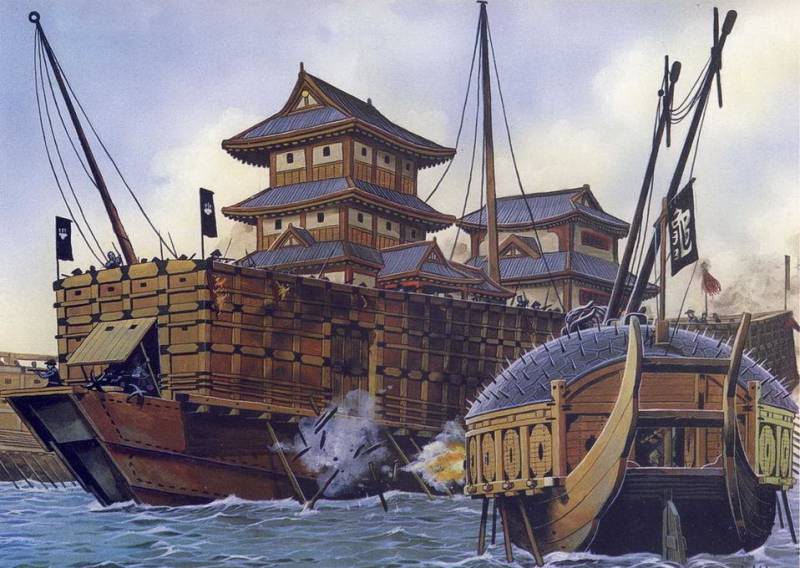
The ship "Nihon-maru" is fighting with kobukson
At the same time, many Japanese managed to escape. Japanese sailors and soldiers who survived the battle landed on the shore. Li Sunsin ordered that several Japanese ships be left unscathed. He motivated this decision by the fact that the Japanese, deprived of the means to save themselves, could recoup the local defenseless Korean population. In an effort also to avoid senseless losses among his soldiers and sailors, the admiral ordered to stop the battle and withdraw to the open sea. When the Korean ships returned to the bay at dawn, they found that the surviving Japanese had fled on the remaining ships.
Thus, none of the civilians suffered. The losses of the Koreans, as in previous naval battles, were negligible - not a single ship was lost. The defeat at Hansando and Angolpo cost the Japanese hundreds of ships and 9 men, while the Koreans lost only 000 killed and 19 wounded. Soon after receiving disturbing news of the Japanese army's invasion of Jeolla Province, Admiral Lee ordered his fleet to return to his main naval base at Yeosu.
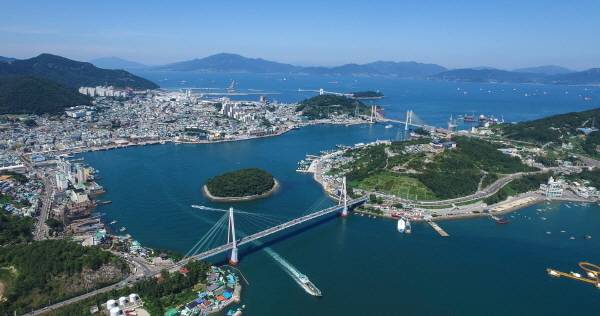
The city of Yeosu, which served as the naval base for Li Songsin's fleet. Modern look
The naval campaign led by Yi Sun-sin in the summer of 1592 was an undoubted triumph for Korean weapons. The actions of the admiral nullified the successes of the Japanese army, as the Koreans were able to cut off its supply.
For Li Sunsin himself, these victories were the first step on the way to the glory of the country's savior and national hero.
Продолжение следует ...
Information